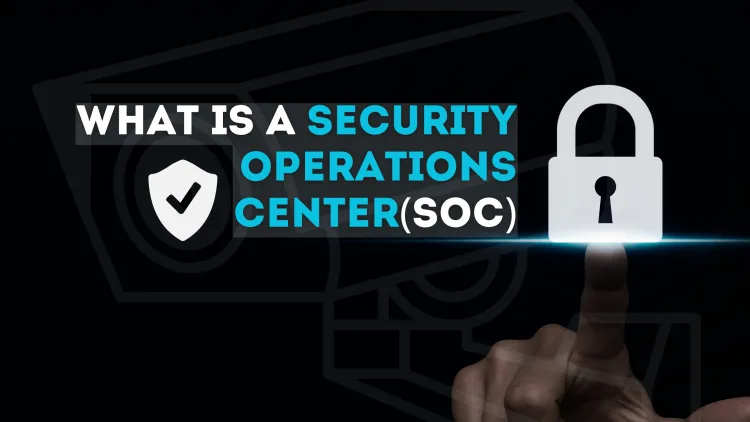What is a Security Operations Center (SOC)?
A Security Operations Center (SOC) is a centralized team responsible for monitoring, detecting, and responding to security threats in real time. SOCs ensure 24/7 protection of organizational systems and data, enhancing cybersecurity resilience. By using tools like SIEM, training skilled analysts, and implementing robust processes, organizations can proactively mitigate risks. SOCs come in different models (internal, outsourced, hybrid) and face challenges like alert fatigue and evolving threats. However, with best practices, a SOC is a vital asset for any organization’s security infrastructure.

In today’s cyber threat landscape, organizations need robust systems to safeguard their digital assets. One of the most critical components of a company's cybersecurity infrastructure is the Security Operations Center (SOC). This blog will dive into what a SOC is, its importance, how it works, and the key elements of an effective SOC.
What is a Security Operations Center (SOC)?
A Security Operations Center (SOC) is a centralized facility or team that monitors, detects, and responds to security threats and incidents in real time. It serves as the backbone of an organization’s cybersecurity framework, ensuring that its systems, data, and networks remain secure from potential attacks.
Key Functions of a SOC:
- Monitoring: Continuously observing systems and networks for suspicious activities.
- Detection: Identifying potential security breaches and vulnerabilities.
- Incident Response: Acting swiftly to mitigate the impact of security incidents.
- Threat Intelligence: Analyzing global cyber threats to stay ahead of potential risks.
- Reporting: Documenting incidents and providing actionable insights for future prevention.
Why is a SOC Important?
In an era where cyberattacks are becoming more frequent and sophisticated, a SOC provides several benefits:
- 24/7 Threat Monitoring: Ensures constant surveillance of an organization’s IT infrastructure.
- Quick Response to Incidents: Reduces downtime and limits the damage caused by cyberattacks.
- Proactive Threat Management: Identifies and mitigates risks before they can be exploited.
- Regulatory Compliance: Helps organizations meet legal and industry-specific cybersecurity requirements.
- Enhanced Business Continuity: Protects critical systems and data, ensuring seamless operations even during an attack.
How Does a SOC Work?
A SOC relies on people, processes, and technology to ensure an organization's security. Here's how these components work together:
1. People
- SOC Analysts: Monitor systems, analyze threats, and respond to incidents.
- Incident Responders: Contain and resolve security breaches.
- Threat Hunters: Proactively search for vulnerabilities and hidden threats.
- SOC Managers: Oversee operations and strategy.
2. Processes
- Incident Management: Guidelines for handling security incidents.
- Change Management: Ensures updates to systems don't create new vulnerabilities.
- Compliance Audits: Ensures security measures meet required standards.
3. Technology
- SIEM (Security Information and Event Management): Centralized system for collecting and analyzing security data.
- Intrusion Detection Systems (IDS): Identify unauthorized access.
- Firewalls: Block malicious traffic.
- Endpoint Detection and Response (EDR): Monitors end-user devices for potential threats.
Key Components of an Effective SOC
-
Threat Intelligence Integration
Using global threat data to enhance detection and response capabilities. -
Advanced Security Tools
Implementing tools like AI-driven threat detection and behavioral analytics. -
Continuous Training
Keeping SOC team members updated on the latest attack vectors and defensive strategies. -
Incident Response Plan
A predefined set of steps for handling security incidents efficiently. -
Regular Security Audits
Ensuring systems and processes are always up to date and secure.
SOC Models
Organizations can implement SOCs in various ways based on their size, budget, and security needs:
1. Internal SOC
- Operated entirely in-house.
- Full control over security operations.
2. Outsourced SOC
- Managed by third-party security providers.
- Cost-effective for small to medium-sized businesses.
3. Hybrid SOC
- Combines internal and external resources.
- Balances cost and control.
Challenges Faced by SOC Teams
Despite their importance, SOCs face several challenges, including:
- Alert Fatigue: Dealing with an overwhelming number of false positives.
- Resource Constraints: Limited budget and skilled personnel.
- Evolving Threats: Adapting to new and sophisticated attack methods.
- Data Overload: Managing large volumes of security data efficiently.
Best Practices for an Efficient SOC
-
Automate Repetitive Tasks
Use AI and machine learning to reduce manual work and focus on critical tasks. -
Enhance Collaboration
Foster clear communication between SOC teams and other departments. -
Conduct Regular Threat Simulations
Test incident response plans through simulated cyberattacks. -
Invest in Threat Intelligence
Stay updated on the latest threats and vulnerabilities. -
Establish Clear KPIs
Measure the SOC’s performance using metrics like response time and incident resolution.
Conclusion
A Security Operations Center (SOC) is vital for any organization aiming to defend its systems against cyber threats. By implementing the right people, processes, and technologies, a SOC can effectively monitor, detect, and respond to incidents, ensuring the safety and integrity of critical assets. Whether managed internally, outsourced, or hybrid, investing in a SOC strengthens an organization's overall security posture.
FAQs
-
What is a Security Operations Center (SOC)?
A SOC is a centralized team or facility that monitors and manages an organization’s security. -
Why is a SOC important?
It provides continuous threat monitoring, incident response, and protection of critical systems. -
Who works in a SOC?
SOC analysts, incident responders, threat hunters, and managers. -
What tools are used in a SOC?
SIEM systems, firewalls, IDS, and endpoint detection tools. -
What are the SOC models?
Internal SOC, outsourced SOC, and hybrid SOC. -
What challenges do SOC teams face?
Alert fatigue, resource constraints, and adapting to evolving threats. -
How does a SOC enhance security?
By detecting threats early and responding quickly to mitigate damage. -
What is SIEM in a SOC?
Security Information and Event Management, a tool for monitoring and analyzing security data. -
How can small businesses use a SOC?
They can outsource SOC services to manage cybersecurity effectively. -
What’s the difference between a SOC and NOC?
A SOC focuses on security, while a NOC (Network Operations Center) manages network performance.














![Top 10 Ethical Hackers in the World [2025]](https://www.webasha.com/blog/uploads/images/202408/image_100x75_66c2f983c207b.webp)








